Lenovo 5053, 5063, 5061, 5057, 5055 User Manual
...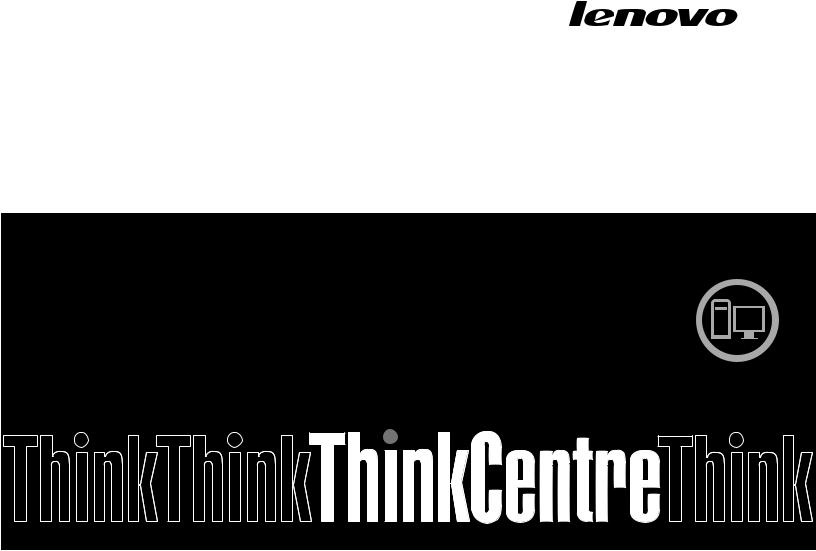
ThinkCentre
User Guide
Machine Types: 4162, 5041, 5044, 5051, 5053, 5055, 5057, 5059, 5061, 5063, and 5065

ThinkCentre
User Guide
Machine Types: 4162, 5041, 5044, 5051, 5053, 5055, 5057, 5059, 5061, 5063, and 5065
Note: Before using this information and the product it supports, be sure to read and understand the
ThinkCentre Safety and Warranty Guide and Appendix A “Notices” on page 63.
Second Edition (November 2010)
© Copyright Lenovo 2010.
LENOVO products, data, computer software, and services have been developed exclusively at private expense and are sold to governmental entities as commercial items as defined by 48 C.F.R. 2.101 with limited and restricted rights to use, reproduction and disclosure.
LIMITED AND RESTRICTED RIGHTS NOTICE: If products, data, computer software, or services are delivered pursuant a General Services Administration “GSA” contract, use, reproduction, or disclosure is subject to restrictions set forth in Contract No. GS-35F-05925.

Contents
Important safety information . . . . . |
. |
v |
Chapter 1. Product overview . . . . . |
. |
1 |
Features . . . . . . . . . . . . . . . . . |
. |
1 |
Specifications . . . . . . . . . . . . . . . |
. |
3 |
Software overview . . . . . . . . . . . . . |
. |
4 |
Software provided with your Windows |
|
|
operating system . . . . . . . . . . . . |
. |
4 |
Locations. . . . . . . . . . . . . . . . . |
. |
6 |
Locating connectors, controls, and indicators |
|
|
on the front of your computer . . . . . . . |
. |
6 |
Locating connectors and parts on the rear of |
|
|
your computer . . . . . . . . . . . . . |
. |
7 |
Locating components . . . . . . . . . . |
. |
9 |
Locating parts on the system board . . . . |
. |
9 |
Locating internal drives . . . . . . . . . |
|
10 |
Chapter 2. Installing or replacing |
|
|
hardware . . . . . . . . . . . . . . . |
|
13 |
Handling static-sensitive devices . . . . . . . |
|
13 |
Installing or replacing hardware . . . . . . . . |
|
13 |
Installing external options . . . . . . . . |
|
13 |
Removing the computer cover. . . . . . . |
|
14 |
Removing and reinstalling the front bezel . . |
|
15 |
Installing or replacing a PCI card . . . . . . |
|
16 |
Installing or replacing a memory module . . . |
|
19 |
Replacing the battery . . . . . . . . . . |
|
20 |
Replacing the power supply assembly . . . |
|
22 |
Replacing the heat sink and fan assembly . . |
|
24 |
Replacing the microprocessor . . . . . . . |
|
26 |
Replacing the optical drive . . . . . . . . |
|
28 |
Replacing the hard disk drive . . . . . . . |
|
30 |
Replacing the front audio and USB |
|
|
assembly . . . . . . . . . . . . . . . |
|
32 |
Replacing the rear fan assembly . . . . . . |
|
33 |
Replacing the keyboard . . . . . . . . . |
|
35 |
Replacing the mouse . . . . . . . . . . |
|
36 |
Completing the parts replacement . . . . . |
|
37 |
Obtaining device drivers . . . . . . . . . . . |
|
38 |
Basic security features . . . . . . . . . . . |
|
38 |
Integrated cable lock . . . . . . . . . . |
|
38 |
Padlock . . . . . . . . . . . . . . . |
|
39 |
Password protection . . . . . . . . . . |
|
39 |
Erasing a lost or forgotten password (clearing |
|
|
CMOS) . . . . . . . . . . . . . . . . |
|
39 |
Chapter 3. Recovery information. . . 41
Creating and using recovery media . . . . . . |
41 |
Creating recovery media . . . . . . . . . |
41 |
Using recovery media . . . . . . . . . . |
42 |
Performing backup and recovery operations . . . |
42 |
Performing a backup operation . . . . . . |
43 |
Performing a recovery operation . . . . . . |
43 |
Using the Rescue and Recovery workspace . . . |
43 |
Creating and using a rescue medium . . . . . . |
44 |
Creating a rescue medium . . . . . . . . |
45 |
Using a rescue medium . . . . . . . . . |
45 |
Installing or reinstalling device drivers . . . . . |
46 |
Solving recovery problems . . . . . . . . . . |
46 |
Chapter 4. Using the Setup Utility |
|
program . . . . . . . . . . . . . . . . |
47 |
Starting the Setup Utility program . . . . . . . |
47 |
Viewing or changing settings . . . . . . . . . |
47 |
Using passwords. . . . . . . . . . . . . . |
47 |
Password considerations . . . . . . . . . |
48 |
Power-on password . . . . . . . . . . . |
48 |
Administrator password . . . . . . . . . |
48 |
Setting, changing, or deleting a password . . |
48 |
Enabling or disabling a device . . . . . . . . |
48 |
Selecting a startup device . . . . . . . . . . |
49 |
Selecting a temporary startup device . . . . |
49 |
Viewing or changing the startup device |
|
sequence . . . . . . . . . . . . . . . |
49 |
Exiting the Setup Utility program . . . . . . . |
50 |
Chapter 5. Updating system |
|
programs . . . . . . . . . . . . . . . |
51 |
Using system programs . . . . . . . . . . . |
51 |
Updating (flashing) the BIOS from a disc . . . . |
51 |
Updating (flashing) the BIOS from your operating |
|
system . . . . . . . . . . . . . . . . . . |
52 |
Recovering from a POST and BIOS update |
|
failure . . . . . . . . . . . . . . . . . . |
52 |
Chapter 6. Troubleshooting and |
|
diagnostic programs . . . . . . . . . |
55 |
Basic troubleshooting . . . . . . . . . . . . |
55 |
Diagnostic programs . . . . . . . . . . . . |
56 |
Lenovo ThinkVantage Toolbox . . . . . . . |
56 |
PC-Doctor for DOS . . . . . . . . . . . |
56 |
Cleaning the mouse . . . . . . . . . . . . |
57 |
Optical mouse . . . . . . . . . . . . . |
57 |
Non-optical mouse . . . . . . . . . . . |
57 |
© Copyright Lenovo 2010 |
iii |
Chapter 7. Getting information, help, |
|
and service . . . . . . . . . . . . . . |
59 |
Information resources . . . . . . . . . . . . |
59 |
Online Books folder . . . . . . . . . . . |
59 |
Lenovo ThinkVantage Tools . . . . . . . . |
59 |
ThinkVantage Productivity Center . . . . . |
60 |
Lenovo Welcome . . . . . . . . . . . . |
60 |
Access Help . . . . . . . . . . . . . . |
60 |
Safety and warranty . . . . . . . . . . . |
60 |
Lenovo Web site (http://www.lenovo.com) . . |
60 |
Help and service . . . . . . . . . . . . . . |
61 |
Using the documentation and diagnostic |
|
programs . . . . . . . . . . . . . . . |
61 |
Calling for service. . . . . . . . . . . . |
61 |
Using other services . . . . . . . . . . |
62 |
Purchasing additional services . . . . . . |
62 |
Appendix A. Notices . . . . . . . . . |
63 |
Television output notice . . . . . . . . . . . |
64 |
European conformance CE mark . . . . . . . |
64 |
Trademarks . . . . . . . . . . . . . . . . |
64 |
Index. . . . . . . . . . . . . . . . . . |
65 |
iv ThinkCentre User Guide

Important safety information
CAUTION:
Before using this manual, be sure to read and understand all the related safety information for this product. Refer to the ThinkCentre Safety and Warranty Guide that you received with this product for the latest safety information. Reading and understanding this safety information reduces the risk of personal injury and or damage to your product.
If you no longer have a copy of the ThinkCentre Safety and Warranty Guide, you can obtain a Portable Document Format (PDF) version from the Lenovo® Support Web site at: http://www.lenovo.com/support
© Copyright Lenovo 2010 |
v |
vi ThinkCentre User Guide

Chapter 1. Product overview
This chapter provides information about the computer features, specifications, software programs provided by Lenovo, and locations of connectors, components, parts on the system board, and internal drives.
This chapter contains the following topics:
•“Features” on page 1: This section provides information about the computer features.
•“Specifications” on page 3: This section lists the physical specifications for your computer.
•“Software overview” on page 4: This section provides information about the software programs provided with your computer.
•“Locations” on page 6: This section provides information to help you locate your computer connectors, components, parts on the system board, and internal drives.
Features
This section provides information about the computer features.
System information
The following information covers a variety of models. For information about your specific model, use the Setup Utility program. See Chapter 4 “Using the Setup Utility program” on page 47.
Microprocessor
Your computer comes with one of the following microprocessors (internal cache size varies by model type):
•AMD® Athlon™ II microprocessor
•AMD Phenom™ II microprocessor
•AMD Sempron™ microprocessor
Memory module(s)
Your computer supports up to four double data rate 3 dual inline memory modules (DDR3 DIMMs).
Internal drives
•Card reader (available in some models)
•Optical drive
•Serial Advanced Technology Attachment (SATA) hard disk drive
Video subsystem
•Integrated graphics card functioning through a Video Graphics Array (VGA) connector or a Digital Visual Interface (DVI) connector
•Peripheral Component Interconnect (PCI) Express x16 graphics card slot on the system board for a discrete graphics card
Audio subsystem
•Integrated high-definition (HD) audio
•Headphone connector and microphone connector on the front panel
© Copyright Lenovo 2010 |
1 |
•Audio line-in connector, audio line-out connector, and microphone connector on the rear panel
•Internal speaker (available in some models)
Connectivity
10/100/1000 Mbps integrated Ethernet controller
System management features
•Ability to store the power-on self-test (POST) hardware test results
•Advanced Configuration and Power Interface (ACPI)
•Automatic power-on startup
•Desktop Management Interface (DMI)
•Preboot Execution Environment (PXE)
•System Management (SM) Basic Input/Output System (BIOS) and SM software
•Wake on LAN (WOL)
•Windows Management Instrumentation (WMI) (WMI is the infrastructure for management data and operations on Windows operating systems.)
Input/Output (I/O) features
•9-pin serial port (one standard and one optional)
•25-pin parallel port (optional through your PCI card in some models)
•Ethernet connector
•PS/2 keyboard connector
•PS/2 mouse connector
•Six Universal Serial Bus (USB) 2.0 connectors (two on the front panel and four on the rear panel; there might also be two optional USB connectors on the rear panel)
•Two audio connectors on the front panel (headphone connector and microphone connector)
•Three audio connectors on the rear panel (audio line-in connector, audio line-out connector, and microphone connector)
•VGA monitor connector and DVI monitor connector
For more information, refer to “Locating connectors, controls, and indicators on the front of your computer” on page 6 and “Locating connectors and parts on the rear of your computer” on page 7.
Expansion
•One optical drive bay
•One slim card reader drive bay
•One PCI card slot
•One PCI Express x16 graphics card slot
•Two hard disk drive bays (one standard and one optional)
•Two PCI Express x1 card slots
Power supply
Your computer comes with one of the following power supplies:
• 280-watt power supply with manual voltage-selection switch
2 ThinkCentre User Guide

•280-watt auto-sensing power supply
•320-watt auto-sensing power supply
Security features
•A power-on password and an administrator password to deter unauthorized use of your computer
•Computrace
•Cover presence switch (also called intrusion switch) (available in some models)
•Enabling or disabling SATA devices
•Enabling or disabling the serial port
•Enabling or disabling USB connectors
•Keyboard with fingerprint reader (shipped with some models)
•Startup sequence control
•Startup without keyboard or mouse
•Support for the addition of an integrated cable lock (Kensington lock. See “Integrated cable lock” on page 38 for more information.)
•Support for the addition of a padlock (see “Padlock” on page 39 for more information)
Preinstalled software programs
Your computer is preinstalled with one of the following operating systems:
•Microsoft® Windows® 7
•Microsoft Windows Vista®
Operating system(s), certified or tested for compatibility1 (varies by model type)
• Linux®
Specifications
This section lists the physical specifications for your computer.
1.The operating system(s) listed here are being certified or tested for compatibility at the time this publication goes to press. Additional operating systems might be identified by Lenovo as compatible with your computer following the publication of this manual. This list is subject to change. To determine if an operating system has been certified or tested for compatibility, check the Web site of the operating system vendor.
Chapter 1. Product overview 3

Dimensions
Width: 160 mm (6.3 inches)
Height: 388 mm (15.28 inches)
Depth: 422 mm (16.61 inches)
Weight
Maximum configuration as shipped: 9.4 kg (20.72 lbs)
Environment
• Air temperature:
Operating: 10°C to 35°C (50°F to 95°F)
Non-operating: -40°C to 60°C (-40°F to 140°F)
Non-operating: -10°C to 60°C (14°F to 140°F) (without package)
• Humidity:
Operating: 20% to 80% (non-condensing)
Non-operating: 20% to 90% (non-condensing)
• Altitude:
Operating: -50 to 10 000 ft (-15.2 to 3 048 m)
Non-operating: -50 to 35 000 ft (-15.2 to 10 668 m)
Electrical input
•Input voltage:
– Low range:
Minimum: 100 V ac
Maximum: 127 V ac
Input frequency range: 50 to 60 Hz
Voltage-selection switch setting: 115 V ac
– High range:
Minimum: 200 V ac
Maximum: 240 V ac
Input frequency range: 50 to 60 Hz
Voltage-selection switch setting: 230 V ac
Software overview
The computer comes with a preinstalled operating system and several software programs provided by Lenovo.
Software provided with your Windows operating system
This section provides information about the software provided with your Windows operating system.
Software provided by Lenovo
The following software programs are provided by Lenovo to help you improve productivity and reduce the cost associated with maintaining your computer. Software programs provided with your computer might vary depending on your model type and preinstalled operating system.
4 ThinkCentre User Guide
Lenovo ThinkVantage Tools
The Lenovo ThinkVantage® Tools program guides you to a host of information sources and provides easy access to various tools to help you work more easily and securely. For more information, see “Lenovo ThinkVantage Tools” on page 59.
Note: The Lenovo ThinkVantage Tools program is only available on computers with the Windows 7 operating system from Lenovo.
ThinkVantage Productivity Center
The ThinkVantage Productivity Center program guides you to a host of information and tools to help you set up, understand, maintain, and enhance your computer.
Note: The ThinkVantage Productivity Center program is only available on computers preinstalled with the Windows Vista operating system from Lenovo.
Lenovo Welcome
The Lenovo Welcome program introduces some innovative built-in features of Lenovo to you and guides you through some important setup tasks to help you make the most of your computer.
Product Recovery
The Product Recovery program enables you to restore the contents of the hard disk drive to the factory default settings.
ThinkVantage Rescue and Recovery
The ThinkVantage Rescue and Recovery® program is a one button recovery and restore solution that includes a set of self-recovery tools to help you diagnose computer problems, get help, and recover from system crashes, even if you cannot start the Windows operating system.
Note: If the Enhanced Backup and Restore icon in the Lenovo ThinkVantage Tools program is dimmed, it indicates that you need to install the Rescue and Recovery program manually before enabling its features. To install the Rescue and Recovery program, do the following:
1.Click Start All Programs Lenovo ThinkVantage Tools, and double-click Enhanced Backup and Restore.
2.Follow the instructions on the screen.
3.When the installation process completes, the Enhanced Backup and Restore icon is activated.
ThinkVantage Client Security Solution
The ThinkVantage Client Security Solution program is available on select Lenovo computers. It helps protect your information, including vital security information like passwords, encryption keys, and electronic credentials, while guarding against unauthorized user access to data.
Note: The ThinkVantage Client Security Solution program is only available on computers preinstalled with the Windows Vista operating system from Lenovo.
Password Manager
The Password Manager program automatically captures and fills in authentication information for Windows applications and Web sites.
Note: The Password Manager program is only available on computers preinstalled with the Windows 7 operating system from Lenovo. If the Password Vault icon in the Lenovo ThinkVantage Tools program is dimmed, it indicates that you need to install the Password Manager program manually before enabling its features. To install the Password Manager program, do the following:
1.Click Start All Programs Lenovo ThinkVantage Tools, and double-click Password Vault.
2.Follow the instructions on the screen.
Chapter 1. Product overview 5

3. When the installation process completes, the Password Vault icon is activated.
Power Manager
The Power Manager program provides convenient, flexible, and complete power management for your ThinkCentre® computer. By using the Power Manager program, you can adjust your power settings to achieve the best balance between system performance and power saving.
ThinkVantage System Update
The ThinkVantage System Update program helps you keep the software on your computer up-to-date by downloading and installing software packages (ThinkVantage applications, device drivers, BIOS updates, and other third party applications).
Fingerprint Software
The integrated fingerprint reader provided on some keyboards works with the Fingerprint Software program to enable you to enroll your fingerprint and associate it with your Windows password. As a result, fingerprint authentication can replace your password and enable simple and secure user access. A fingerprint reader keyboard is available with certain computers or can be purchased for computers that support this option.
Lenovo ThinkVantage Toolbox
The Lenovo ThinkVantage Toolbox program helps you maintain your computer, improve computing security, diagnose computer problems, get familiar with the innovative technologies provided by Lenovo, and get more information about your computer. For more information, see “Lenovo ThinkVantage Toolbox” on page 56.
Adobe Reader
The Adobe Reader program is a tool used to view, print, and search PDF documents.
See “Online Books folder” on page 59 for more information about accessing and viewing the publications.
Antivirus software
Your computer comes with antivirus software that you can use to detect and eliminate viruses. Lenovo provides a full version of antivirus software on your computer with a free 30-day subscription. After 30 days, you must renew the license to continue receiving the antivirus software updates.
For more information about how to use your antivirus software, refer to the help system of your antivirus software.
Locations
This section provides information to help you locate your computer connectors, components, parts on the system board, and internal drives.
Note: The components in your computer might look slightly different from the illustrations.
Locating connectors, controls, and indicators on the front of your computer
Figure 1 “Front connector, control, and indicator locations” on page 7 shows the locations of the connectors, controls, and indicators on the front of your computer.
6 ThinkCentre User Guide
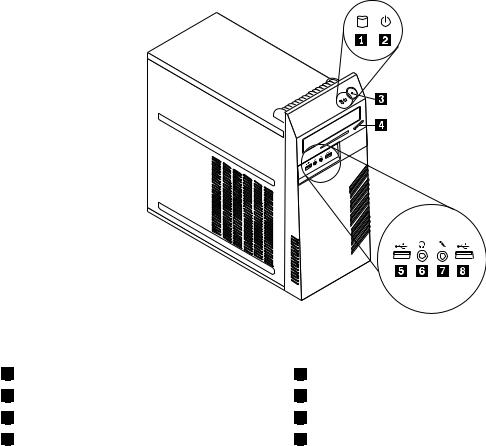
Figure 1. Front connector, control, and indicator locations
1 |
Hard disk drive activity indicator |
2 |
Power indicator |
3 |
Power switch |
4 |
Optical drive eject/close button |
5 |
USB connector |
6 |
Headphone connector |
7 |
Microphone connector |
8 |
USB connector |
Locating connectors and parts on the rear of your computer
Figure 2 “Rear connector and part locations” on page 8 shows the locations of the connectors and parts on the rear of your computer. Some connectors on the rear of your computer are color-coded to help you determine where to connect the cables on your computer.
Chapter 1. Product overview 7
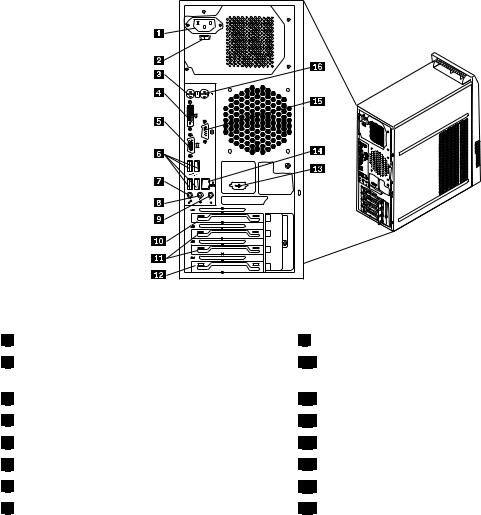
Figure 2. Rear connector and part locations
1 |
Power cord connector |
2 Voltage-selection switch (available on some models)
3 |
PS/2 keyboard connector |
4 |
DVI monitor connector |
5 |
VGA monitor connector |
6 |
USB connectors (4) |
7 |
Microphone connector |
8 |
Audio line-out connector |
9 Audio line-in connector
10 PCI Express x16 graphics card slot
11 PCI Express x1 card slots (2)
12 PCI card slot
13 Serial port (available in some models)
14 Ethernet connector
15 Serial port
16 PS/2 mouse connector
Connector |
Description |
Audio line-in connector |
Used to receive audio signals from an external audio device, such as a stereo |
|
system. When you attach an external audio device, a cable is connected between |
|
the audio line-out connector of the device and the audio line-in connector of |
|
the computer. |
Audio line-out connector |
Used to send audio signals from the computer to external devices, such as |
|
powered stereo speakers (speakers with built-in amplifiers), headphones, |
|
multimedia keyboards, the audio line-in connector on a stereo system, or other |
|
external recording devices. |
DVI monitor connector |
Used to attach a DVI monitor or other devices that use a DVI monitor connector. |
Ethernet connector |
Used to attach an Ethernet cable for a local area network (LAN). |
|
Note: To operate the computer within FCC Class B limits, use a Category 5 |
|
Ethernet cable. |
Microphone connector |
Used to attach a microphone to your computer when you want to record sound or |
|
if you use speech-recognition software. |
PS/2 keyboard connector |
Used to attach a keyboard that uses a PS/2 keyboard connector. |
PS/2 mouse connector |
Used to attach a mouse, a trackball, or other pointing devices that use a PS/2 |
|
mouse connector. |
8 ThinkCentre User Guide
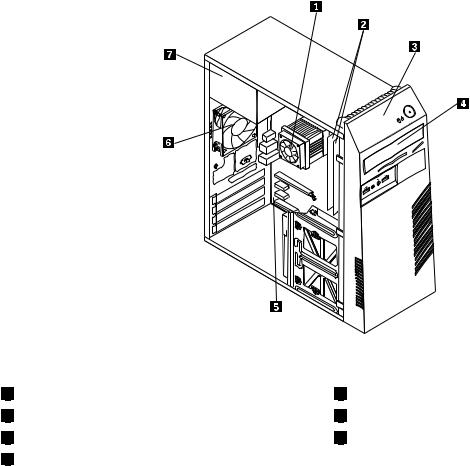
Connector |
Description |
Serial port |
Used to attach an external modem, a serial printer, or other devices that use a |
|
9-pin serial port. |
USB connector |
Used to attach a device that uses a USB connector, such as a USB keyboard, |
|
a USB mouse, a USB scanner, or a USB printer. If the USB connectors on your |
|
computer are not enough for you to connect all your USB devices, you can |
|
purchase a USB hub, which you can use to connect additional USB devices. |
VGA monitor connector |
Used to attach a VGA monitor or other devices that use a VGA monitor connector. |
Locating components
Figure 3 “Component locations” on page 9 shows the locations of the various components in your computer. To remove the computer cover and gain access to the inside of the computer, see “Removing the computer cover” on page 14.
Figure 3. Component locations
1 |
Heat sink and fan assembly |
2 |
Memory modules (2) |
3 |
Front bezel |
4 |
Optical drive |
5 |
System board |
6 |
Rear fan assembly |
7 |
Power supply assembly |
Locating parts on the system board
Figure 4 “System board part locations” on page 10 shows the locations of the parts on the system board.
Chapter 1. Product overview 9
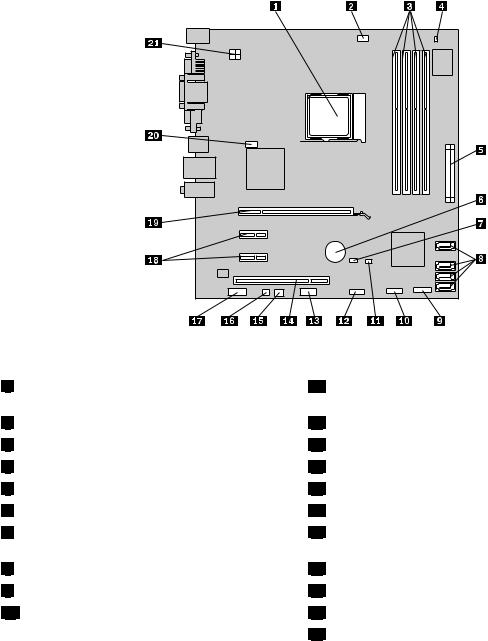
Figure 4. System board part locations
1 |
Microprocessor |
2Microprocessor fan connector
3Memory slots (4)
4Thermal sensor connector
524-pin power connector
6Battery
7Clear CMOS (Complementary Metal Oxide Semiconductor) /Recovery jumper
8SATA connectors (4)
9Front panel connector
10Front USB connector
11Cover presence switch connector (also called intrusion switch connector)
12Front USB connector
13Serial (COM 2) connector
14PCI card slot
15Power fan connector
16Internal speaker connector
17Front audio connector
18 |
PCI Express x1 card slots (2) |
19 |
PCI Express x16 graphics card slot |
20 |
System fan connector |
21 |
4-pin power connector |
Locating internal drives
Internal drives are devices that your computer uses to read and store data. You can add drives to your computer to increase storage capacity and enable your computer to read other types of media. Internal drives are installed in bays. In this manual, the bays are referred to as bay 1, bay 2, and so on.
When installing or replacing an internal drive, it is important to note the type and size of the drive that you can install or replace in each bay and correctly connect the cables to the drive installed. Refer to the appropriate section in Chapter 2 “Installing or replacing hardware” on page 13 for instructions on how to install or replace internal drives for your computer.
Figure 5 “Drive bay locations” on page 11 shows the locations of the drive bays in your computer.
10 ThinkCentre User Guide
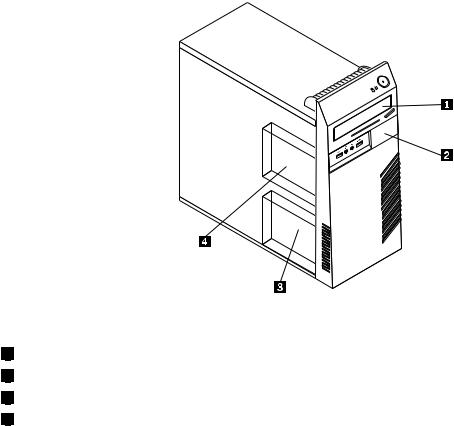
Figure 5. Drive bay locations
1Bay 1 - Optical drive bay (with an optical drive installed)
2Bay 2 - Slim card reader drive bay
3Bay 3 - Primary SATA hard disk drive bay (with a 3.5-inch SATA hard disk drive installed)
4Bay 4 - Secondary SATA hard disk drive bay
Chapter 1. Product overview 11
12 ThinkCentre User Guide

Chapter 2. Installing or replacing hardware
This chapter provides instructions on how to install or replace hardware for your computer.
This chapter contains the following topics:
•“Handling static-sensitive devices” on page 13
•“Installing or replacing hardware” on page 13
•“Obtaining device drivers” on page 38
•“Basic security features” on page 38
Handling static-sensitive devices
Do not open the static-protective package containing the new part until the defective part has been removed from the computer and you are ready to install the new part. Static electricity, although harmless to you, can seriously damage computer components and parts.
When you handle computer parts and components, take these precautions to avoid static-electricity damage:
•Limit your movement. Movement can cause static electricity to build up around you.
•Always carefully handle the parts and other computer components. Handle PCI cards, memory modules, system boards, and microprocessors by the edges. Never touch exposed circuitry.
•Prevent others from touching the parts and other computer components.
•Before you replace a new part, touch the static-protective package containing the new part to a metal expansion-slot cover or other unpainted metal surface on the computer for at least two seconds. This reduces static electricity from the package and your body.
•Remove the new part from the static-protective package and directly install it in the computer without placing it on any other surface. If it is hard for you to do this in your specific situation, place the static-protective package of the new part on a smooth, level surface, and then place the new part on the static-protective package.
•Do not place the part on the computer cover or other metal surface.
Installing or replacing hardware
This section provides instructions on how to install or replace hardware for your computer. You can expand the capabilities of your computer by adding memory modules, PCI cards, or drives, and maintain your computer by replacing the failing hardware.
Notes:
1.Use only computer parts provided by Lenovo.
2.When installing or replacing an option, use the appropriate instructions in this section along with the instructions that come with the option.
Installing external options
You can install external options to your computer, such as external speakers, a printer, or a scanner. For some external options, you must install additional software in addition to making the physical connection. When you install an external option, see “Locating connectors, controls, and indicators on the front of your computer” on page 6 and “Locating connectors and parts on the rear of your computer” on page 7 to
© Copyright Lenovo 2010 |
13 |
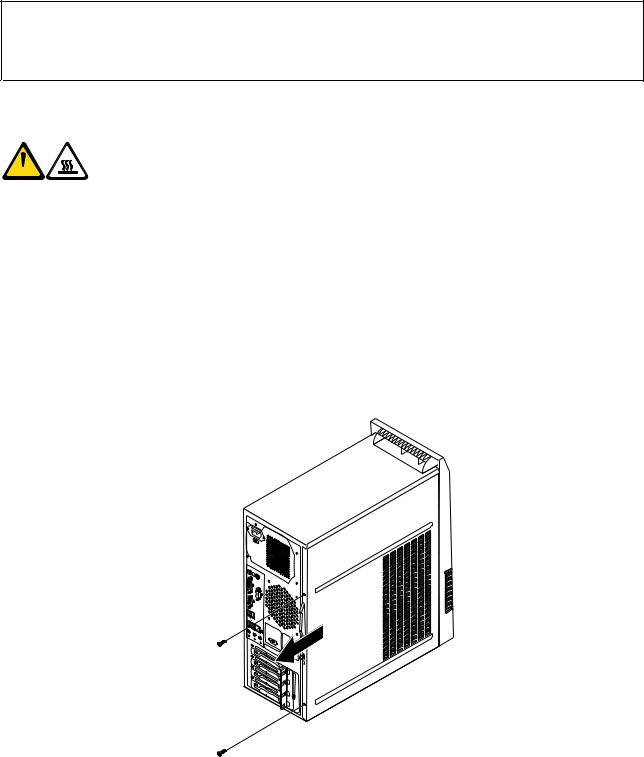
identify the required connector. Then, use the instructions that come with the option to help you make the connection and install software or device drivers that are required for the option.
Removing the computer cover
Attention:
Do not open your computer or attempt any repair before reading and understanding the “Important safety information” in the ThinkCentre Safety and Warranty Guide that came with your computer. To obtain a copy of the ThinkCentre Safety and Warranty Guide, go to:
http://www.lenovo.com/support
This section provides instructions on how to remove the computer cover.
CAUTION:
 Turn off the computer and wait three to five minutes to let the computer cool before removing the computer cover.
Turn off the computer and wait three to five minutes to let the computer cool before removing the computer cover.
To remove the computer cover, do the following:
1.Remove all media from the drives. Then, turn off all attached devices and the computer.
2.Disconnect all power cords from electrical outlets.
3.Disconnect the power cord, Input/Output cables, and all other cables that are connected to the computer.
4.Remove any locking device that secures the computer cover, such as an integrated cable lock or a padlock. See “Integrated cable lock” on page 38 or “Padlock” on page 39.
5.Remove the two screws that secure the computer cover and slide the computer cover to the rear to remove it.
Figure 6. Removing the computer cover
14 ThinkCentre User Guide
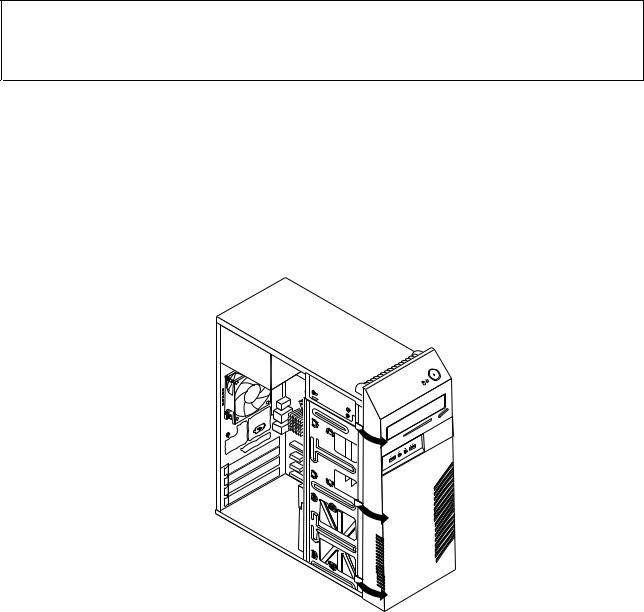
Removing and reinstalling the front bezel
Attention:
Do not open your computer or attempt any repair before reading and understanding the “Important safety information” in the ThinkCentre Safety and Warranty Guide that came with your computer. To obtain a copy of the ThinkCentre Safety and Warranty Guide, go to:
http://www.lenovo.com/support
This section provides instructions on how to remove and reinstall the front bezel.
To remove and reinstall the front bezel, do the following:
1.Remove all media from the drives and turn off all attached devices and the computer. Then, disconnect all power cords from electrical outlets and disconnect all cables that are connected to the computer.
2.Remove the computer cover. See “Removing the computer cover” on page 14.
3.Remove the front bezel by releasing the three plastic tabs on the left side and pivoting the front bezel outward.
Figure 7. Removing the front bezel
4.To reinstall the front bezel, align the other three plastic tabs on the right side of the front bezel with the corresponding holes in the chassis, then pivot the front bezel inward until it snaps into position on the left side.
Chapter 2. Installing or replacing hardware 15
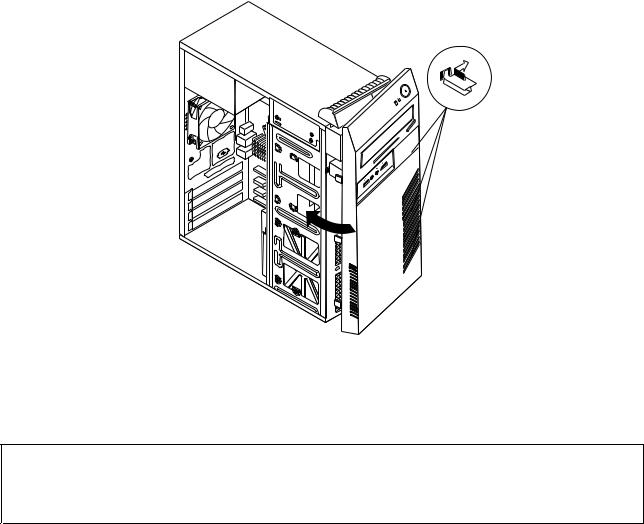
Figure 8. Reinstalling the front bezel
5. Go to “Completing the parts replacement” on page 37.
Installing or replacing a PCI card
Attention:
Do not open your computer or attempt any repair before reading and understanding the “Important safety information” in the ThinkCentre Safety and Warranty Guide that came with your computer. To obtain a copy of the ThinkCentre Safety and Warranty Guide, go to:
http://www.lenovo.com/support
This section provides instructions on how to install or replace a PCI card.
Your computer has one standard PCI card slot, two PCI Express x1 card slots, and one PCI Express x16 graphics card slot. See “Locating parts on the system board” on page 9.
To install or replace a PCI card, do the following:
1.Remove all media from the drives and turn off all attached devices and the computer. Then, disconnect all power cords from electrical outlets and disconnect all cables that are connected to the computer.
2.Remove the computer cover. See “Removing the computer cover” on page 14.
3.At the rear of the computer, remove the screw that secures the PCI card latch.
16 ThinkCentre User Guide
